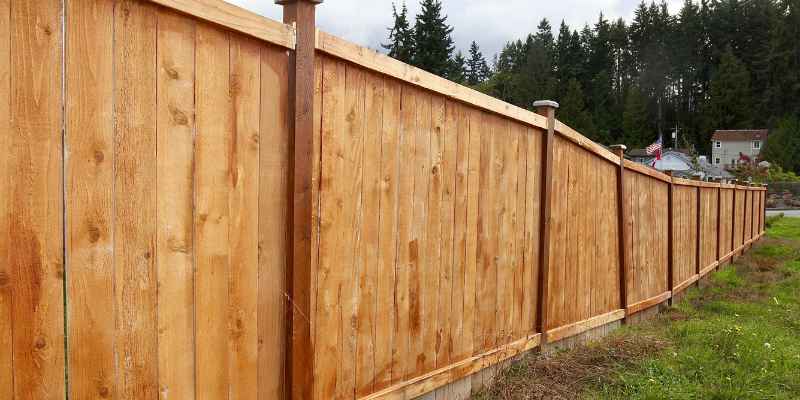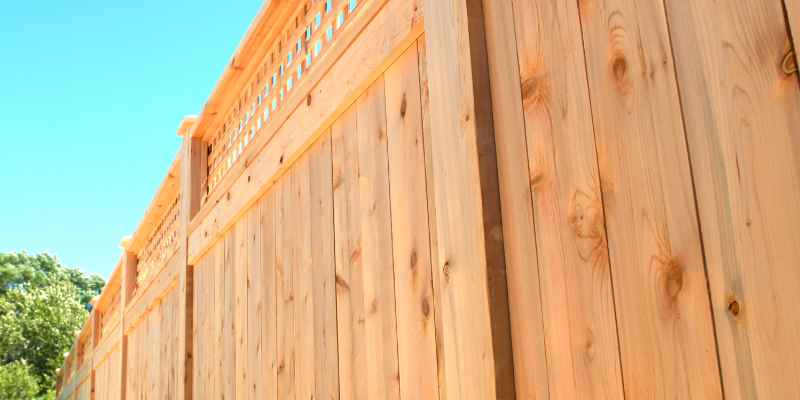When comparing cedar vs pressure-treated wood, cedar is more appealing and rot-resistant, while pressure-treated wood is sturdier and weather-proof. In terms of aesthetics and durability, cedar is often preferred for its natural look and resistance to rot, making it ideal for above-ground portions like fence panels.
On the other hand, pressure-treated wood, especially pine, is recommended for fence posts due to its longevity and strength against outdoor elements like moisture and insects. Understanding the differences between these two options can help you make an informed decision based on your specific needs and preferences.
Introduction To Wood Choices For Outdoor Projects
When it comes to outdoor projects, choosing the right type of wood is essential for durability and longevity. Two popular options often considered are cedar and pressure-treated wood. Understanding the differences between these two choices will help you make an informed decision for your outdoor project needs.
Popularity Of Cedar And Pressure Treated Wood
Cedar and pressure-treated wood are both widely used for outdoor projects, but for different reasons. Let’s take a closer look at the popularity of each:
- Cedar: Known for its natural beauty, cedar is a popular choice among homeowners and contractors. It has an attractive grain pattern and a warm, reddish-brown color that adds a touch of elegance to any outdoor project. Cedar is also highly resistant to insects and decay, making it a durable option for long-lasting structures.
- Pressure Treated Wood: Pressure-treated wood, on the other hand, is favored for its affordability and versatility. It is treated with chemicals to increase its resistance to rot, insects, and decay. This makes it a practical choice for outdoor projects that require durability and protection against the elements. Pressure-treated wood is widely available and can be easily found at most hardware stores.
Factors Influencing Wood Durability Outdoors
Several factors influence the durability of wood when used outdoors. Understanding these factors will help you determine which wood choice is best for your specific project:
- Moisture Exposure: Exposure to moisture is one of the biggest challenges for outdoor wood. Cedar naturally contains oils that make it resistant to moisture, while pressure-treated wood is chemically treated to enhance its moisture resistance. Both options can withstand moisture to some extent, but cedar has a slight advantage in this regard.
- UV Exposure: Sunlight can cause wood to fade and deteriorate over time. Cedar has natural UV-resistant properties, which helps it maintain its color and appearance even with prolonged exposure to sunlight. Pressure-treated wood, however, may require regular staining or painting to protect it from UV damage.
- Maintenance: Cedar requires minimal maintenance, typically only needing to be sealed or stained every few years to maintain its natural beauty. On the other hand, pressure-treated wood may require more frequent maintenance, including regular sealing, staining, or painting to prevent decay and maintain its appearance.

Characteristics Of Cedar
Cedar offers natural beauty and durability, making it resistant to rot and insect damage. In contrast, pressure-treated wood is infused with chemicals to enhance its longevity but may not match the aesthetic appeal of cedar. Cedar is a popular choice for outdoor projects due to its longevity and attractive appearance.
Natural Resistance To Elements
Cedar wood is known for its exceptional natural resistance to various elements. One of the key advantages of cedar over pressure-treated wood is its ability to withstand harsh weather conditions without the need for excessive maintenance. Cedar contains natural oils that act as a barrier against moisture, preventing the wood from rotting or warping over time. Additionally, these oils also make cedar highly resistant to insect infestations, such as termites and carpenter ants. This natural resistance to elements makes cedar an ideal choice for outdoor projects, such as fences, decks, and garden beds.
Aesthetic Appeal And Maintenance
In addition to its functional benefits, cedar also offers a visually appealing aesthetic that can enhance the overall look of your outdoor space. The warm, reddish-brown hue of cedar gives it a natural beauty that is hard to replicate with pressure-treated wood. Over time, cedar develops an attractive silver-gray patina when exposed to the elements, further enhancing its visual appeal.
Furthermore, cedar requires minimal maintenance compared to pressure-treated wood. While pressure-treated wood may need to be stained or painted regularly to maintain its appearance and protect it from the elements, cedar can be left untreated and will still age gracefully. However, if you want to preserve the original color of cedar, you can choose to apply a protective sealant or stain.
Overall, the natural resistance to elements and the aesthetic appeal of cedar make it a popular choice for outdoor projects. Its durability, combined with its low maintenance requirements, ensures that cedar will continue to look beautiful and withstand the test of time. Whether you’re building a fence, deck, or garden bed, cedar offers a versatile and long-lasting option that will add value and charm to your outdoor space.
Pros And Cons Of Pressure Treated Wood
Enhanced Durability With Chemical Treatments
Pressure treated wood offers enhanced durability due to the infusion of chemical preservatives. These preservatives protect the wood from decay, rot, and insect damage, making it ideal for outdoor applications.
Considerations For Weather-proofing
When it comes to weather-proofing, pressure treated wood excels in resisting moisture and weather elements. The chemical treatments provide a barrier against rot and decay, ensuring longevity even in harsh outdoor environments.
Comparative Analysis: Lifespan And Longevity
When considering the choice between cedar and pressure-treated wood for outdoor projects, it’s crucial to evaluate their respective lifespans and longevity. Understanding the factors that influence the longevity of these wood types is essential for making an informed decision.
Average Lifespan Outdoors
Both cedar and pressure-treated wood have distinct average lifespans when used outdoors. While pressure-treated wood is engineered to resist rot, decay, and insect infestation, cedar boasts natural resistance to decay and rot. On average, pressure-treated wood can last anywhere from 15 to 20 years, whereas cedar can endure for 20 to 30 years under optimal conditions.
Factors Affecting Wood Longevity
- Moisture Levels: Excessive moisture can accelerate the decay of both cedar and pressure-treated wood.
- Exposure to Elements: Sunlight, rain, and temperature fluctuations play a significant role in the degradation of outdoor wood structures.
- Maintenance: Regular maintenance and sealing can prolong the lifespan of both cedar and pressure-treated wood.
- Quality of Wood: The grade and quality of the wood used can directly impact its longevity.
Resistance To Rot And Insect Damage
When comparing Cedar vs Pressure Treated wood, one crucial aspect to consider is their resistance to rot and insect damage.
Cedar’s Natural Defenses
Cedar wood naturally contains oils and tannins that act as protective barriers against rot and insects.
Effectiveness Of Pressure Treatment
Pressure-treated wood undergoes a chemical treatment process, infusing preservatives deep into the wood to enhance its rot and insect resistance.
Cost Considerations
When considering cost between cedar and pressure treated wood, it’s important to weigh the upfront expenses against long-term maintenance. While cedar may have a higher initial cost, its natural resistance to decay and insects can reduce the need for ongoing treatments and repairs, potentially making it a more cost-effective choice over time.
Initial Investment
When considering the initial investment for a fence or deck project, pressure-treated wood is typically less expensive than cedar. This is because pressure-treated wood is chemically treated to resist rot, decay, and insect damage, which makes it more widely available and affordable. Cedar, on the other hand, is a natural wood that requires less processing but can be more expensive due to its durability and natural resistance to decay and insect damage.
Long-term Value
Although pressure-treated wood may be less expensive initially, it may not provide the same long-term value as cedar. Cedar is a naturally rot-resistant wood that can last for decades without chemical treatment. This means that cedar may require less maintenance and replacement over time, which can save you money in the long run. Pressure-treated wood, however, may require more frequent maintenance and replacement due to its susceptibility to rot, decay, and insect damage.
Replacement Costs
When it comes to replacement costs, pressure-treated wood may be less expensive than cedar in the short term. However, if you consider the long-term value of cedar, it may actually be more cost-effective in the long run. This is because cedar can last for decades without needing to be replaced, while pressure-treated wood may require more frequent replacements due to its susceptibility to rot, decay, and insect damage. Additionally, the cost of replacing a fence or deck can add up quickly, so investing in a durable material like cedar may ultimately save you money in the long run.
In conclusion, while pressure-treated wood may be less expensive initially, cedar may provide more long-term value and ultimately save you money in the long run. When considering cost considerations for your fence or deck project, it is important to weigh the initial investment, long-term value, and replacement costs of both materials.
Environmental And Health Implications
When it comes to choosing between cedar and pressure-treated wood, it’s essential to consider the environmental and health implications. Both options have their own set of eco-friendliness and safety concerns that can impact the overall sustainability and well-being of your project.
Eco-friendliness Of Cedar
Cedar is renowned for its eco-friendly properties, making it a popular choice for environmentally conscious individuals. It is a sustainable and renewable resource, known for its natural resistance to decay and insects. The production of cedar lumber involves minimal processing, reducing the environmental impact compared to other wood treatments.
Safety Concerns With Pressure Treated Wood
Pressure-treated wood, on the other hand, raises safety concerns due to the chemical treatment process. The wood is infused with preservatives, such as arsenic and chromium, to enhance its durability. However, these chemicals can pose health risks if proper precautions are not taken during handling and construction. As a result, there are potential environmental implications associated with the disposal of pressure-treated wood waste.
Maintenance And Care
When it comes to ensuring the longevity and aesthetics of your outdoor wood structures, maintenance and care are essential factors to consider. Let’s explore the specific requirements for preserving the natural beauty of cedar and maintaining pressure-treated wood.
Preserving Cedar’s Natural Beauty
Cedar, known for its natural beauty and durability, requires regular maintenance to preserve its appearance and structural integrity. Here are some key points to consider:
- Apply a high-quality wood sealer to protect against moisture and UV rays.
- Regularly clean the surface to remove dirt and debris.
- Inspect for cracks or splinters and address them promptly to prevent further damage.
- Stain or reapply sealant as needed to maintain the wood’s color and protection.
Maintaining Pressure Treated Wood
Pressure-treated wood offers resistance to decay and insect infestation, but proper maintenance is still crucial for long-term performance. Consider the following maintenance tasks:
- Regularly clean the surface using a mild detergent and water to remove dirt and mildew.
- Inspect for signs of wear, such as cracking or warping, and address any issues promptly.
- Reapply a water repellent or sealant as needed to maintain the wood’s protective properties.
- Consider applying a stain to enhance the wood’s appearance and provide additional protection.
Decision-making Guide
Choosing the right type of wood is crucial when it comes to building a fence, deck, or any outdoor project. Cedar and pressure-treated wood are two of the most popular choices, but which one is right for your project? In this decision-making guide, we will help you assess the right wood for your project based on regional considerations and climate adaptability.
Assessing The Right Wood For Your Project
Before deciding between cedar and pressure-treated wood, consider the following factors:
- Budget: Pressure-treated wood is typically less expensive than cedar.
- Maintenance: Cedar requires less maintenance than pressure-treated wood.
- Aesthetics: Cedar has a natural beauty and can be left unfinished, while pressure-treated wood can be painted or stained.
- Durability: Pressure-treated wood is treated with chemicals to resist rot and insects, while cedar has natural resistance to both.
Regional Considerations And Climate Adaptability
Regional considerations and climate adaptability are also important factors to consider when choosing between cedar and pressure-treated wood. Here are some things to keep in mind:
| Region | Climate | Best Wood Option |
|---|---|---|
| Coastal Areas | High Humidity, Saltwater Exposure | Cedar |
| Southern US | Hot, Humid Summers | Pressure-Treated Wood |
| Mountain West | Cold Winters, Dry Summers | Cedar |
It’s important to choose a wood that can withstand the climate in your area. Cedar is a good choice for coastal areas because it is resistant to saltwater exposure, while pressure-treated wood is better for hot and humid climates. In colder regions with dry summers, cedar is a good choice because it can handle the extreme temperature changes.
Conclusion: The Better Choice For Your Outdoor Space
When deciding between cedar and pressure treated wood for your outdoor space, consider the durability and maintenance requirements. Pressure treated wood is sturdier and more weather-proof, resistant to insects and rot. Cedar, on the other hand, offers a natural look and is recommended for fence posts.
Make an informed choice based on your needs and preferences.
Start of the blog section
Summarizing Key Points
Cedar Vs Pressure Treated: Cedar offers natural beauty and rot resistance, while pressure-treated wood is cost-effective and durable.
- Cedar: Attractive, rot-resistant, but higher maintenance.
- Pressure Treated: Budget-friendly, durable, but may contain chemicals.
Final Recommendations
For a long-lasting and visually appealing outdoor space, consider using a combination of pressure-treated pine for the posts and cedar for the rest of the structure.

Frequently Asked Questions
Is Pressure-treated Wood Better Than Cedar?
Pressure-treated wood is generally considered better than cedar due to its increased durability and resistance to insects and rot. While cedar has a more natural look and is often preferred for aesthetic reasons, pressure-treated wood is sturdier and more weather-proof.
For the longest-lasting and best-looking fence, it is recommended to use pressure-treated pine for the posts and cedar for the rest of the fence.
What Lasts Longer, A Cedar Or Pressure Treated Fence?
For the longest lasting fence, use pressure treated pine for posts and cedar for the rest.
What Are The Disadvantages Of Cedar Wood?
Cedar wood has a few disadvantages, including a shorter lifespan compared to some other hardwoods, susceptibility to dents in certain softwood varieties, higher cost than pine, and the need for regular maintenance to prevent color fading from chemical reactions.
How Long Will Treated Cedar Last Outside?
Treated cedar can last outside for 20-30 years, depending on weather conditions and maintenance.
Conclusion
Overall, when it comes to choosing between cedar and pressure treated wood, there are several factors to consider. Cedar is more expensive but has a natural look and is resistant to insects and rot. Pressure treated wood is more affordable, durable and requires less maintenance.
Ultimately, the decision depends on your budget, aesthetic preferences and the intended use of the wood. It is important to weigh the pros and cons before making a decision.


